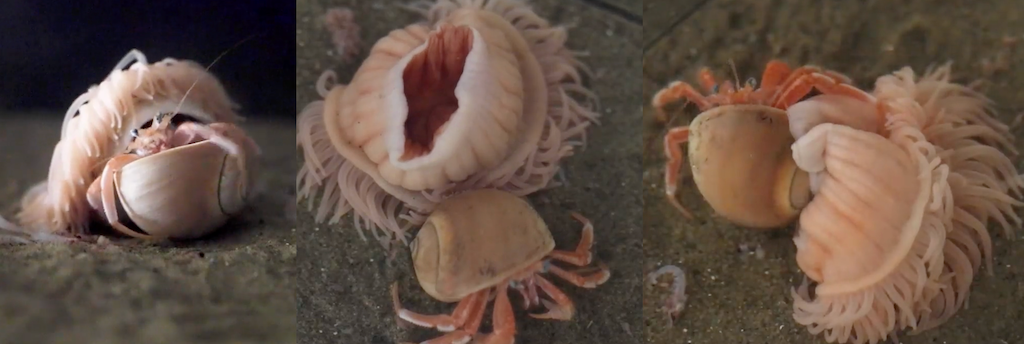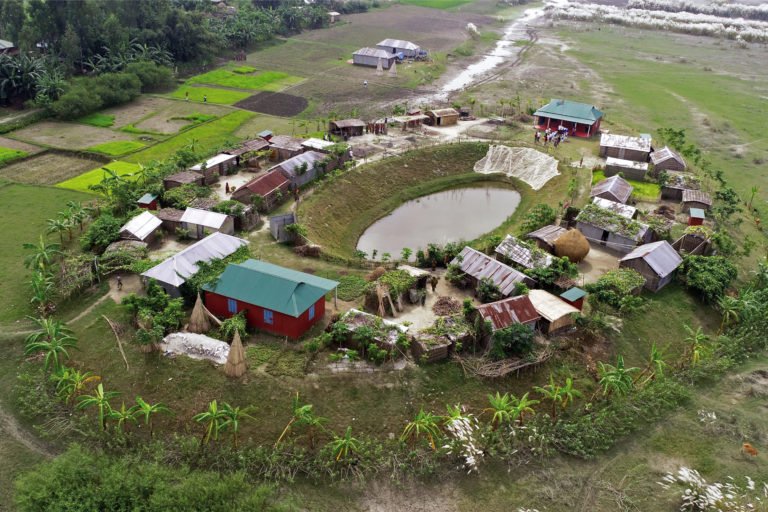- A newly described anemone species has been found off the coast of Japan and appears to live exclusively on the shells of one hermit crab species.
- First-of-its-kind video recordings of the hermit crab and anemone duo show the hermit crab moving to a new shell and spending more than 40 hours poking, peeling and dragging the anemone to come along.
- Researchers believe the hermit crab and anemone are in an obligate symbiotic relationship, or that they need each other to survive.
- The anemone eats falling debris and protects the hermit crab from parasites and predators, and in turn, gets to hitch a ride to fresh feeding grounds.
In deep waters off the coast of Japan, a hermit crab is wearing haute couture. On its shell is the new-to-science anemone species Stylobates calcifer, named after the fire demon Calcifer from the novel and Studio Ghibli film Howl’s Moving Castle.
A research team led by Akihiro Yoshikawa, a professor from the University of Tokyo, collected the anemone-hermit crab duo from the sea floor at a depth of 100 to 400 meters (330 to1,300 feet) in the sea of Kumano and Suruga Bay on the Pacific side of Japan. Researchers have published descriptions of the new anemone species in The Biological Bulletin.
The newly described anemone species appears to live exclusively on the shells of the hermit crab species Pagurodofleinia doederleini, a hint that these two species are in an obligate symbiotic relationship, or that they need each other to survive.
Much like a conch shell, anemones use their own secretions to form their shell-like attachments (in this case, to their hermit crab host). “The shell-making ability of the new species in the species-specific relationship appears as if Calcifer was in a magical contract with the Wizard Howl, constructing his Moving Castle,” Yoshikawa told Mongabay in an email.
In a series of first-ever video recordings of the hermit crab and anemone duo, the crab is seen moving into a larger shell. What follows is a struggle of more than 40 hours to relocate the anemone to the new shell home. The crab pinches, taps and maneuvers the anemone until it’s positioned up on top of the shell, its tentacles facing upright.
Researchers say this immense effort by the hermit crab is further evidence that the hermit crab and the anemone are engaged in a mutualism. The anemone eats falling debris from the ocean above, and in doing so protects the hermit crab from parasites and predators. In return, the anemone gets to hitch a ride to fresh feeding grounds.
“Our study is perhaps the first observation of the behavioral interaction of the rarely studied amazing mutualism in the deep sea,” Yoshikawa said.

There are at least 35 other symbiotic sea anemone species known to science that live on the shells of hermit crabs. This newest species is the fifth of its genus but the first found in Japanese waters.
The shell-like attachments made by the anemone make them susceptible to ocean acidification, Yoshikawa said. As more CO2 is pumped into the atmosphere, some of this enters the ocean, shifting the pH of seawater to make it more acidic. This change in ocean chemistry can cause problems for shells and carcinoecium-forming sea creatures.
The new anemone lives in shallower waters than some of the other Stylobates species, making it easier to catch by deep-sea trawl fishing, a practice that involves dragging massive nets along the seafloor, indiscriminately collecting ocean life. Although scientists don’t know enough about the new species to say for sure, the anemone has been found in trawling bycatch and could be at risk from this practice.
Citation:
Yoshikawa, A., Izumi, T., Moritaki, T., Kimura, T., & Yanagi, K. (2022). Carcinoecium-forming sea anemone Stylobates calcifer sp. nov. (Cnidaria, Actiniaria, Actiniidae) from the Japanese deep-sea floor: A taxonomical description with its ecological observations. The Biological Bulletin, 242(2), 127-152. doi:10.1086/719160
Banner image of the new-to-science anemone species Stylobates calcifer. Image by Akihiro Yoshikawa.
Liz Kimbrough is a staff writer for Mongabay. Find her on Twitter @lizkimbrough
FEEDBACK: Use this form to send a message to the author of this post. If you want to post a public comment, you can do that at the bottom of the page.










